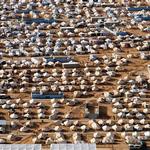Mu'askar and Shu'fat: Retracing the Histories of Two Palestinian Refugee Camps in Jerusalem
While most Palestinian refugee camps were established as part of emergency operations after the wars in 1948 and 1967, Shu‘fat camp in Jerusalem was built between the two wars. The project intended to remove refugees residing in Mu‘askar, an unofficial refugee camp in the Old City’s Jewish quarter, to this new camp four kilometers north of the city center. Planning started in 1959 but, due to complications, Shu‘fat camp was only inhabited from 1966. After 1967, Israel’s annexation of East Jerusalem deeply affected both Mu‘askar and Shu‘fat. More than seventy years after 1948, no comprehensive history of Palestinian refugee camps exists. The microhistory of Mu‘askar and Shu‘fat, involving refugees, UNRWA, and the Jordanian and Israeli governments, is one piece of this wider history. Mu‘askar exemplifies history and presence erased and Shu‘fat illuminates contradictions of planning a long-term refugee camp from scratch. The article traces the evolution of the camp as a site of belonging and ownership and explores history’s contributions to this field.



